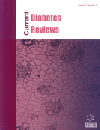- Home
- A-Z Publications
- Current Diabetes Reviews
- Previous Issues
- Volume 9, Issue 3, 2013
Current Diabetes Reviews - Volume 9, Issue 3, 2013
Volume 9, Issue 3, 2013
-
-
The Science of Hypoglycemia in Patients with Diabetes
More LessThe risk of hypoglycemia with anti-hyperglycemic agents is an important limiting factor in the management of type 1 (T1DM) and type 2 (T2DM) diabetes mellitus. While hypoglycemia is more common in T1DM, the incidence is high in T2DM patients who use insulin or secretagogues, particularly patients with longer duration of diabetes. The underlying cause of hypoglycemia in diabetes is a complex interaction betwee Read More
-
-
-
Identifying Risk Factors for Clinically Significant Diabetic Macula Edema in Patients with Type 2 Diabetes Mellitus
More LessAuthors: Kyuzi Kamoi, Keiji Takeda, Kaoru Hashimoto, Reiko Tanaka and Shinya OkuyamaHigh clinic blood pressure (BP), male sex, cigarette smoking, dyslipidemia, renal function, anemia and thiazolidenediones (TZD) treatment are known predictors for clinically significant diabetic macula edema (CSDME). This study was performed to identify the most significant risk factors for CSDME in Japanese patients with type 2 diabetes mellitus (T2DM) and retinopathy (DR), using optical coherence tomography (OCT) if ne Read More
-
-
-
Alzheimer's Disease and Diabetes: New Insights and Unifying Therapies
More LessSeveral research groups have begun to associate the Alzheimer Disease (AD) to Diabetes Mellitus (DM), obesity and cardiovascular disease. This relationship is so close that some authors have defined Alzheimer Disease as Type 3 Diabetes. Numerous studies have shown that people with type 2 diabetes have twice the incidence of sporadic AD. Insulin deficiency or insulin resistance facilitates cerebral β-amyloidogenesis in muri Read More
-
-
-
Modulation of P2 Receptors on Pancreatic β-cells by Agonists and Antagonists: A Molecular Target for Type 2 Diabetes Treatment
More LessMorbidity and mortality from diabetes mellitus (DM) are serious worldwide concerns. By the year 2030, the estimated number of diabetic patients will reach a staggering 439 million worldwide. Diabetes mellitus type 2 (DM2), which involves disturbances in both insulin secretion and resistance, is the most common form of diabetes and affects approximately 5 to 7% of the world's population. When a patient with DM2 cannot regul Read More
-
-
-
Role of Sulfur Containing Amino Acids as an Adjuvant Therapy in the Prevention of Diabetes and its Associated Complications
More LessAuthors: Prasenjit Manna, Joydeep Das and Parames C. SilAmino acid supplementation is gaining acceptance as an important adjuvant therapy in the treatment of diabetes and its associated complications. Numerous studies in the literature report the impaired amino acid metabolism in diabetes and the beneficial effects of amino acids are positively correlated with the increase in plasma levels of those amino acids. Oxidative stress is known to play a major role in diabetic pathophysio Read More
-
-
-
Potential Role of Rho Kinase Inhibitors in Combating Diabetes-Related Complications Including Diabetic Neuropathy-A Review
More LessAuthors: Ram Kumar Mishra, Reshma Alokam, Dharmarajan Sriram and Perumal YogeeswariThe worldwide epidemic scale of diabetes mellitus has been underestimated for a long time. Currently every 10 seconds one patient dies of diabetes-related pathologies. Given the high risk and prevalence of secondary complications as well as individual predisposition to target organ injury, diabetes is one of the major risk factors for various organ and tissue dysfunctions including nerves. The present review outlines th Read More
-
-
-
Insulin Neuritis and Diabetic Cachectic Neuropathy: A Review
More LessAuthors: Michael Knopp, Maithili Srikantha and Yusuf A. RajaballyDiabetic patients can be affected by a wide range of peripheral nerve disorders, the rarer of which are often poorly recognised and understood. “Insulin neuritis” or “treatment induced neuropathy” is a reversible disorder characterised by acute severe distal limb pain, peripheral nerve fibre damage and autonomic dysfunction, preceded by a period of rapid glycaemic control. The condition has been reported in both type 1 a Read More
-
Volumes & issues
-
Volume 21 (2025)
-
Volume 20 (2024)
-
Volume 19 (2023)
-
Volume 18 (2022)
-
Volume 17 (2021)
-
Volume 16 (2020)
-
Volume 15 (2019)
-
Volume 14 (2018)
-
Volume 13 (2017)
-
Volume 12 (2016)
-
Volume 11 (2015)
-
Volume 10 (2014)
-
Volume 9 (2013)
-
Volume 8 (2012)
-
Volume 7 (2011)
-
Volume 6 (2010)
-
Volume 5 (2009)
-
Volume 4 (2008)
-
Volume 3 (2007)
-
Volume 2 (2006)
-
Volume 1 (2005)
Most Read This Month
Article
content/journals/cdr
Journal
10
5
false
en


